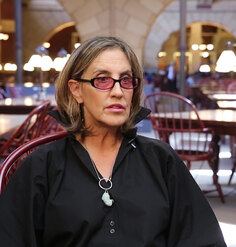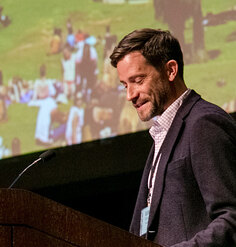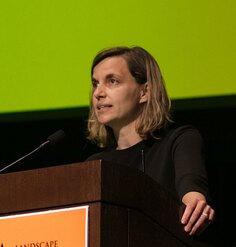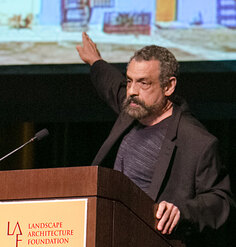Evolution and Prospective Outlook
By Mario Schjetnan
This presentation was part of the Landscape Architecture Foundation’s The New Landscape Declaration: A Summit on Landscape Architecture and the Future held in Philadelphia on June 10-11, 2016. LAF asked a diverse group of leading minds to write a “Declaration” reflecting on the last half century and offering bold ideas for how landscape architecture can make its vital contribution in response to the challenges of our time.
Mario Schjetnan
Founder, Grupo de Diseño Urbano
Mexico City, Mexico
Mario Schjetnan is founder and director of Grupo de Diseño Urbano/GDU, an interdisciplinary design group connecting landscape architecture, architecture, and urban design in spatial, aesthetic, and social contexts. He earned a degree in architecture from the National Autonomous University of Mexico (UNAM) and a master of landscape architecture, with an emphasis in urban design, at the University of California, Berkeley.
* Affiliation at the time of the Summit
Evolution and Prospective Outlook
by Mario Schjetnan
The Landscape Architecture Foundation’s 1966 Declaration of Concern established very clearly the concern for poor environmental conditions, social inequalities, and loss of quality of life prevalent in most North American cities at the time. It was a timely and valorous call, a moral outcry by landscape architecture leaders of the time.
To be sure, many US cities in the past 50 years have improved their levels of air quality, decreased their contamination of soils and water, and upgraded their public open spaces. Many cities have rehabilitated and repopulated their city centers and become more habitable in general. However, many other challenges and global concerns have now arisen, including climate change and the horizontal expansion of cities; and the United States still maintains the highest levels of consumption in the world, per person, of natural resources, energy, land, and water.
Fifty years ago, Latin America had few landscape architects and not a single organized professional society or specialized school. Today, there are several universities offering master’s degrees in landscape architecture and 16 associations registered with the International Federation of Landscape Architects (IFLA). However, in the past 50 years, the damage to the environment has grown exponentially, with desertification and the loss of many ecosystems, including enormous chunks of the Amazon jungle, rainforests, wetlands, and mangrove swamps. Deterioration affects not only local and regional communities but also environmental conditions at the global level. (In Mexico, 300,000 to 400,000 people abandon their land each year because of soil degradation—erosion and salinization.)
The urban environment in Latin America has seen phenomenal expansion. Today, Latin America has sixty-six metropolises of more than one million inhabitants and five megalopolises with ten million inhabitants or more (Buenos Aires, Lima, Mexico City, Rio de Janeiro, and São Paulo). Although many landscape architects actively participate in government and private or social organizations, their numbers are small—disproportionately small compared to the amount of environmental problems and conditions of large numbers of urban dwellers. This is unacceptable. While there are 150,000 architects in Mexico alone, fewer than 1,000 landscape architects work in the country. (In 2015, the Urban Mobility Observatory of the Development Bank of Latin America studied 15 metropolises and found that these cities had problems of congestion and contamination, with 24 million cars, 1 million buses, and 590,000 taxis. The inhabitants lost more than 118 million hours a year just in transportation.)
Most of the global urban expansion in the next 50 years will be in the so-called developing economies: Africa, China, India, and Latin America. According to the Economist, developing economies already surpass developed economies or the so-called rich countries—including the United States, European countries, Australia, and New Zealand—in multiple indicators such as consumption, exports, imports, oil, steel (75 percent), and cement. In 2011, subscriptions to mobile phone services topped 82 percent, and 52 percent of all purchases of motor vehicles occurred in these economies.
Therefore, our call or declaration must be global because much of the environmental impact and urban growth is happening in the developing world. Eurocentric or US-centric visions must change if landscape architects aspire to influence in meaningful ways the development of urban places and the viability and conservation of world resources. Among the issues to consider are that green technologies, sustainable societies and cities, and the green economy are terribly relevant for our means and aspirations; a green economy and technology can provide jobs and generate new economies and synergies. (In 2015, Mexico exported more dollars in the agroindustry than in the petroleum or tourist industries.) In addition, the profession of landscape architecture is a major player, a means to achieve environmental justice and social equality, as well as avoid urban and rural marginality. Landscape architects must be educated, enabled, and fit to lead an authentic and urgent green revolution for a sustainable, viable, and just planet; and substantial numbers of candidates for degrees in landscape architecture will need to study in North American universities and return to their home countries.
The Landscape Architecture Foundation can document and disseminate cases of successful interventions where landscape architects have improved and positively transformed communities, environments, landscapes, portions of cities, as well as people's lives, particularly in developing countries.











